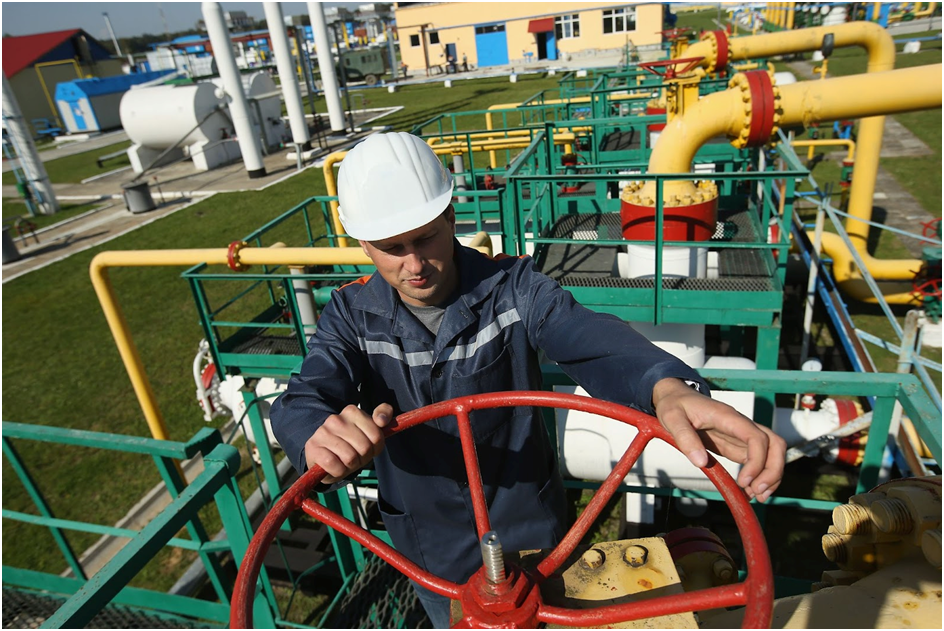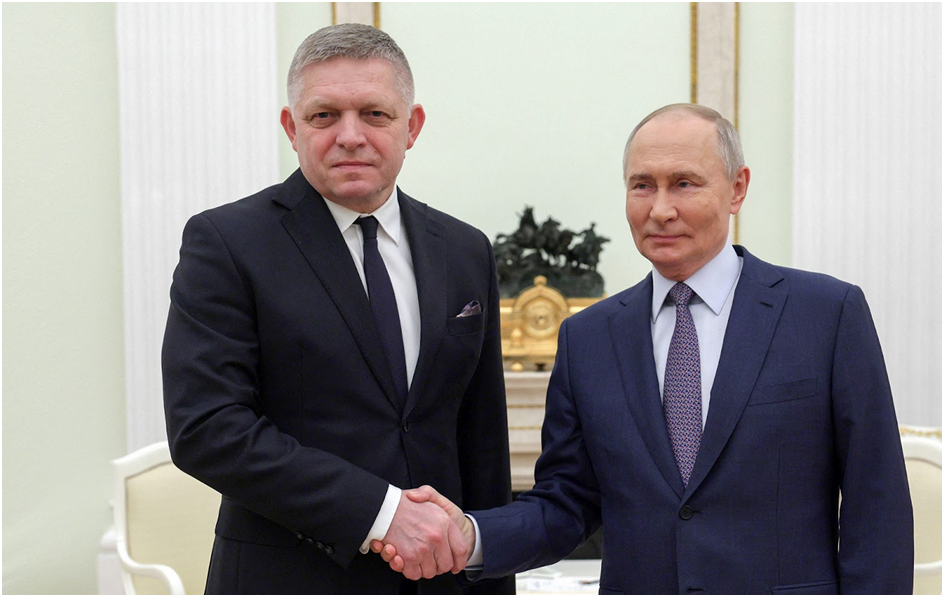The transit of Russian gas through Ukraine to Europe and Moldova has been stopped after the termination of the contract between Naftogaz and Gazprom. RBC-Ukraine analyzes what the consequences could be for the EU, Ukraine, and Moldova.
Contents
- 5 years of contract in numbers
- Slovakia and Hungary continue to hope for transit
- No transit despite the terms of Association Agreement with EU
- Implications for Ukraine, EU, and Moldova
Today, on January 1, 2025, natural gas supplies from Russia through Ukraine to European countries and Moldova stopped. This is confirmed by the data of the GTS Operator. At 7 a.m. Kyiv time, the taps were turned off both at the Russian border with Ukraine and at the Ukrainian border with Slovakia. Thus, the 5-year transit contract between Naftogaz of Ukraine and Gazprom, signed on December 30, 2019, expired.
This was the second commercial transit contract in the history of Ukrainian-Russian relations, after the 11-year (2009-2019) contract of 2008. 16 years ago, the agreement was signed in Moscow under serious pressure from the EU countries, which were deprived of Russian gas for almost three weeks due to Russia’s decision to cut off transit on January 1, 2009. At the time, this happened because the governments of Yulia Tymoshenko and Vladimir Putin had not agreed on the terms of Ukraine’s gas purchases and transit to the EU.
For the EU, the issue of gas supplies in 2009 was extremely acute, as its dependence on Russian energy was much greater – more than 100 billion cubic meters a year transited through Ukraine to the EU. Recently, transit has been slightly above 15 billion cubic meters and accounts for only 5% of total gas consumption in the EU.
The 2019 transit contract was prepared as a separate agreement – Ukraine has not bought gas from Russia since the end of 2015. The document was signed remotely – at that time, Naftogaz CEO Yurii Vitrenko was in Vienna, and Gazprom CEO Alexey Miller was in St. Petersburg.
5 years of contract in numbers
The contract was a compromise solution after the Russians lost in the Stockholm arbitration. As a result of the agreement, Gazprom paid about $2.9 billion to Naftogaz. Ukraine, on the other hand, dropped all existing and new lawsuits and arbitration claims.
The agreement provided for the supply of gas for transit on a pump-or-pay basis and monthly prepayment for 65 billion cubic meters of gas in 2020 and 40 billion in the next four years. It also provided for the possibility of extending the contract for another 10 years.
RBC-Ukraine has already written about how the contract was fulfilled by the parties throughout its validity. Over 5 years, about 148 billion cubic meters of gas passed through Ukraine, while 225 billion cubic meters were to be paid for, which is about $8.6 billion.
However, in 2022, transit dropped to 20.46 billion cubic meters due to the cessation of supplies through the Sokhranovka gas distribution station in the Luhansk region. Ukraine did not have control over the station but received confirmation that gas was being stolen from it in the occupied territories. In 2023, transit dropped to 14.65 billion cubic meters and went through only one point – the Sudzha GCS in the Kursk region. In 2024, the transit volume is expected to be about 15.4 billion cubic meters. In 2022, Gazprom did not agree to redirect gas from Sokhranovka to Sudzha and reduced the payment.
Naftogaz considered this a breach of contract and went to arbitration. A year ago, the amount of the claim was $700 million. Now it has increased, but Naftogaz does not disclose the exact figures.
 Gas transit through Ukraine has been stopped (photo: GettyImages)
Gas transit through Ukraine has been stopped (photo: GettyImages)
Gazprom’s revenues during the contract period were many times higher. Even with the reduction in supply volumes in 2023-2024, they amounted to about $6 billion a year. These figures are provided by the former head of the Ukrainian GTS Operator, Serhii Makohon.
Slovakia and Hungary continue to hope for transit
The termination of transit was not a surprise to anyone. More than a year ago, Ukraine said that the contract would not be extended. In December 2023, Oleksii Chernyshov, the former head of Naftogaz, was one of the first to say so in an interview with RBC-Ukraine. The European Union has been preparing to reduce gas supplies from Russia since 2022 when it decided to get rid of dependence on Russian oil and gas by 2027.
Former European Commissioner for Energy Kadri Simson has repeatedly spoken about the EU’s readiness to stop transit. Her successor, Dan Jørgensen, takes the same position. “In my first 100 days, I will present a plan on how to speed up ending our reliance on Russian gas before 2027,” he said before taking up his new position on December 1.
The supply of liquefied natural gas (LNG), an alternative to Russian gas, to the EU has been significantly increased in recent years by the United States, with Norway becoming the main supplier. Recently, the head of the European Commission, Ursula von der Leyen, suggested to the newly elected US President Donald Trump that the US should increase LNG supplies even more.
Most EU countries have already found a replacement for Russia’s Gazprom. Among them are Austria and Italy. By the way, gas supplies to Austria were cut off at the initiative of Gazprom itself a month and a half ago.
Even Hungary, which at the beginning of the year raised the issue of continuing transit at bilateral meetings, has found an alternative route through the Turkish Stream. However, Budapest still hopes for transit through Ukraine, as it is a cheaper route. The other day, Hungarian Prime Minister Viktor Orbán said that negotiations with Russia and Ukraine on preserving gas transit are ongoing. “We are now trying a trick… what if the gas, by the time it enters the territory of Ukraine, will no longer be Russian, but will already belong to the buyers,” he said.
It is unclear what kind of trick Orbán was referring to. Perhaps he was talking about applying to gas the scheme that Hungary already uses when supplying oil through Ukraine. Its essence is that Russian oil is bought by a Hungarian company at the border, and it enters Ukraine as a Hungarian product. And now they want to do the same with gas. But this option will not work for Kyiv.
Against the backdrop of Hungary and Slovakia’s desire to find a suitable option to preserve transit in the European energy market, it is said, jokingly or seriously, that Budapest has decided to enter one of the Russian production companies so that the gas that will transit through Ukraine will be considered Hungarian. “It is not yet clear whether this is true or not, but the idea itself is quite creative,” said a source with contacts in the EU energy market.
Even if true, the realization of such a trick is unlikely. Exports of pipeline gas to Russia are limited – only Gazprom can do it. Even Rosneft has not yet been granted the right to do so. Although given that gas issues in Russia are being resolved, especially now, in the political rather than economic sphere, no options can be ruled out.
But Slovakia is being the most active now. It keeps trying to achieve its goal and force Ukraine to agree to transit. Bratislava considered the option of buying gas from Azerbaijan with deliveries via Russia and Ukraine. But Baku does not have free resources for supplies, so gas would have to be purchased from Russia. Consultations on a new supply scheme lasted quite a while. Ukraine even offered its vision of the issue – pumping gas into storage with subsequent re-export. But none of the options was recognized as realistic. Gas supplies from Azerbaijan would have involved purchasing it from Russia, and Ukraine does not intend to continue financing Russia. Volodymyr Zelenskyy personally told Slovak Prime Minister Robert Fico on December 19.
Just a few days later, Fico flew to Moscow to discuss the gas issue with Putin. Then he issued an ultimatum, saying that if transit was stopped, Bratislava would stop supplying electricity to Ukraine.
 Slovakia and Russia discuss gas transit (photo: GettyImages)
Slovakia and Russia discuss gas transit (photo: GettyImages)
Ukraine is not afraid of such threats. If Slovakia, which covers 19% of electricity imports, refuses, other partners such as Poland, Hungary, and Romania will be able to increase supplies. If Hungary also joins Slovakia’s ultimatum, Ukraine will have a formal reason to retaliate against the supply of oil to refineries in these two countries, which continues to flow through the Druzhba pipeline.
Fico’s trip to Moscow was publicly condemned in some EU countries, including Lithuania and Czechia. Lithuanian President Gitanas Nausėda said that Fico was seeking to preserve the transit of cheap Russian gas, even if it meant dealing with a war criminal. The European Commission’s leadership refrained from assessing the visit but made it clear that they do not support Slovakia’s desire to preserve transit. “Stopping transit through Ukraine on January 1 is an expected situation, and the EU is ready for it,” IF-Ukraine reports, citing an EC representative.
No transit despite the terms of Association Agreement with EU
To confirm the likelihood of continuing transit in Ukraine, a condition of the Association Agreement with the EU was sometimes cited. According to the agreement, Ukraine cannot refuse an EU country if it applies for a reservation of GTS capacity for transit.
But from January 1, this condition will no longer apply, as the first day of 2025 will see the expiration of not only the transit contract but also the technical agreement between the system operators of Ukraine and Russia (GTSOU and Gazprom – ed.).
While the contract defines commercial relations, the agreement between the operators defines the technical aspects of transit. That is, how much gas is transported, when, and how it is transported. Without such a document, the capacities cannot be put up for auction and, accordingly, cannot be bid for and purchased.
“There can be no bids because the capacities have not been sold, and not sold because there is no agreement,” a source at a major Ukrainian energy company told the agency.
According to RBC-Ukraine, GTSOU has no plans to sign a technical agreement with Gazprom soon. But if there is political will, it can be signed at any time. According to Makohon, the technical agreement for the contract in 2018 was signed the morning of the day before the New Year. “I signed the agreement at 4:38 a.m. on December 30,” said the former head of the GTSOU.
Implications for Ukraine, the EU and Moldova
After the transit is completed, no one will stop the operation of the Ukrainian gas transportation system. It will continue to serve as a domestic gas distribution system and an additional gas storage facility. The role of the GTS is important for the supply of gas from underground storage facilities located in the west Ukraine to the central and eastern regions.
However, the system will require additional funds, which until 2025 were received through transit fees. For this purpose, gas transportation tariffs for domestic consumers have already been increased. The increase will not affect the population – it will be only for business. But even for them, the increase in tariffs will be insignificant, said Volodymyr Omelchenko, director of energy programs at the Razumkov Center. “In the total price of gas, the cost of transportation through main gas pipelines is up to 5%, so the increase will not be significant,” he said in a commentary to RBC-Ukraine. New tariffs for gas entry/exit to the Ukrainian gas transportation system at external points on the borders with Slovakia, Hungary, Poland, and Moldova for export-import operations have also been set. These tariffs were increased by more than 2 times.
Omelchenko noted that a negative consequence of the termination of transit could be a shortage of gas in Ukraine by the end of the heating season. “So far, not enough gas has been purchased, and at the end of the season there may be problems with lifting gas from the underground storage facilities due to low pressure,” the expert believes.
Omelchenko does not predict any problems for Europe. Gas storage facilities there were almost full by the beginning of the heating season. Almost all EU countries have found alternative ways to provide themselves with energy resources. And Slovakia, Omelchenko said, will eventually be able to find gas for itself as well. “The previous government of this country has already developed a package of alternative contracts that can be implemented,” he emphasized.
Moldova may face problems, as it is likely to face a shortage of electricity. RBC-Ukraine wrote in detail about the risks for Chisinau after the transit is completed. So far, the Moldovan state power plant, which was supplied with Russian gas, has stockpiled coal and fuel oil. Chisinau has stockpiled gas for several months and hopes for Romania’s help with electricity supplies if MoldGRES is unable to cover the country’s needs.
As for the prospects of the Ukrainian gas transportation system, it is quite difficult to make any predictions. But in any case, it is too early to scrap it. The GTS has been and remains a fairly profitable gas supply route. And it is possible that its use may become relevant again over time.


 Gas transit through Ukraine has been stopped (photo: GettyImages)
Gas transit through Ukraine has been stopped (photo: GettyImages) Slovakia and Russia discuss gas transit (photo: GettyImages)
Slovakia and Russia discuss gas transit (photo: GettyImages)